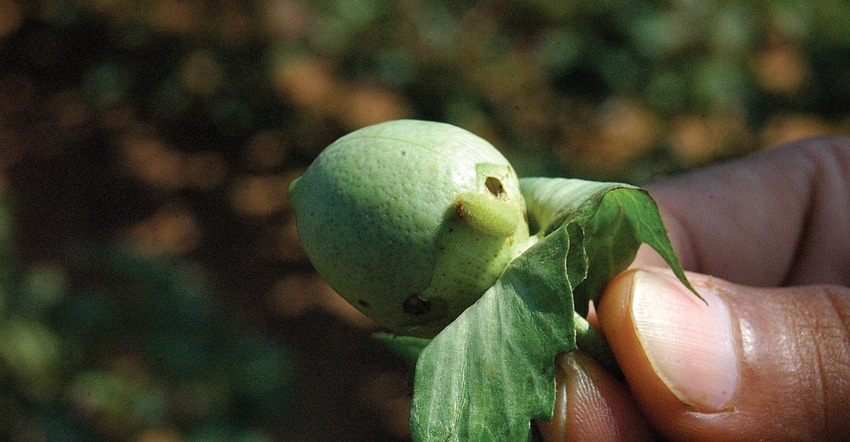November 1, 2021

The USDA estimates that roughly 80% of corn acres and 90% of cotton acres are planted in Bt-trait seed. The benefits of Bt are tremendous. But there’s also a continuous crusade to combat potential resistance to corn earworm and cotton bollworm damage.
Mid-South Extension entomologists contend that by managing the complexity of the earworm/bollworm complex, growers are better armed to stay ahead of worm resistance issues. It boils down to more use of Vip3a, or 3-gene Bt cotton varieties.
Louisiana State University’s Tyler Towles and Mississippi State University’s Jeff Gore say better comprehension of the worm’s growth and infestation patterns can help producers select the best Bt-gene to match their crop rotation and production environment.
Corn earworms annually complete several generations in the southeast. “The first generation begins as eggs laid by adults that have overwintered as pupae in the soil,” Towles says. “Early season hosts such as crimson clover are abundant in the landscape since they are used for erosion control along highways and ditch banks.
“Once the first generation larvae pupate and become adult moths, they move into young, reproductive corn where they begin to lay eggs on silks. Depending on corn planting dates, this usually takes place around late May to early June.”
Earworms feed inside corn ears until they pass through 5 or 6 growth stages called instars. Once earworms reach the last instar, they leave the ear and move down the corn plant to the ground where pupation occurs, Towles says.
“Following pupation, new earworm moths emerge from the ground and begin searching for a new host. Historically, we see the third generation of corn earworms move into cotton in early to middle July.”
2-gene resistance
Moth flights into cotton can continue well into August. Scouting for bollworms is essential, and not just in non-Bt varieties. “Damage has been seen the past few years in dual-gene cotton varieties due to resistance development,” Towles says. “Making a timely application of an insecticide on bollworm eggs in cotton will help prevent damage when those eggs hatch and become larvae.”

Economic thresholds to trigger insecticide treatments depend on a cotton variety’s Bt package. “For non-Bt and 2-gene cotton varieties, we recommend making foliar insecticide applications at 20% cotton bollworm egg lays,” Towles says. “If you find at least one cotton bollworm egg on 20 plants in a 100-plant sample — it’s time to spray.”
Many cotton farmers still use 2-gene Bt cotton varieties. But they often depend on crop consultants to map out a treatment strategy if thresholds are surpassed. “These varieties still provide some protection from bollworm infestations,” Towles points out. “However, they also require insecticide applications if that egg-lay threshold is met and that can be expensive.”
Gore says that the impact of 2-gene resistance is different between corn and cotton. “There is little difference between 2-gene corn and non-Bt corn in terms of corn earworm feeding, but the difference in damage between unsprayed non-Bt cotton and unsprayed Bollgard 2 cotton is still big,” he says.
“If we see 60% fruit damage in non-Bt cotton, it will usually only be 10% to 20% in 2-gene cotton, which is still above threshold. The 2-gene cotton is still providing control, just not enough control or as much control as it used to provide.”
3-gene confidence
Plant breeders work for years to develop seed varieties and hybrids to help prepare producers for resistance to genetically modified traits. The Vip3a Bt trait entered the seed market several years ago and is providing dependable protection against bollworms and earworms.
“Vip3a expressing corn hybrids and cotton varieties are offering good protection against corn earworm/cotton bollworm in the southeast,” Towles says. “I would encourage growers to begin moving to those trait packages in cotton.
“The 3-gene packages allow the traits to kill the bollworm larvae. But I would strongly advise growers and crop consultants to continue scouting 3-gene varieties because none of these trait packages are invincible.”
In scouting 3-gene cotton varieties, don’t rely on an egg lay threshold. Instead, scout for larvae. “Thresholds trigger when 4% live larvae that measure greater than 1/8 of an inch long are present, or when 6% fruit damage of any kind is found,” Towles says.
Gore agrees that Vip varieties should still be scouted for escaped worms and sprayed based on the damage threshold. “We have seen rare instances where bollworms can cause economic damage in Bollgard 3 cotton under extremely high pressure,” he explains. “Scouting is critical in all cotton, including those with Vip.”

With corn earworms/bollworms in cotton, Bt resistance is likely to be transient from field to field and year to year. “Issues with the Vip technology could crop up quickly because bollworms already have some resistance to the other Bt proteins,” Gore says.
“We will likely see potential issues start to show up in corn first, which will give us time to react in cotton and adjust our recommendations and thresholds.”
It may come down to corn hybrid selection in a field being rotated with 3-gene cotton. “Since Bt corn is the preceding host before bollworm populations that infest cotton, we believe that the few cases of resistance we’re seeing in these Bt crops is due to corn and cotton sharing very similar Bt proteins,” Towles says.
“Since Vip3A is doing a lot of the legwork against bollworms in cotton, we must protect that protein. This is accomplished by refraining from planting field corn hybrids that express the Vip3A protein.”
Field to field analysis will likely be needed to judge how the earworm/bollworm complex is impacting a farm’s situation. “It’s important to consider what other pests may also be in the field at damaging levels then decide if and when to apply insecticides,” Towles says.
“For instance, if growers or consultants are finding sub-threshold bollworm eggs or larvae, but tarnished plant bugs are above threshold, it makes more sense from an economic standpoint to trigger the bollworm application early so the plane/sprayer only crosses the field once.”
About the Author(s)
You May Also Like




